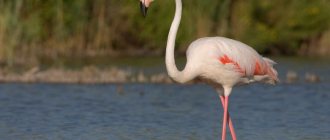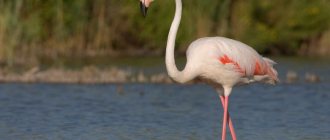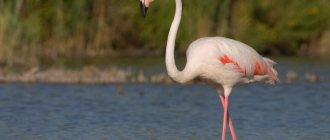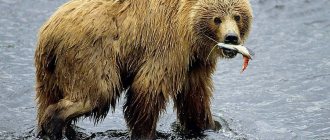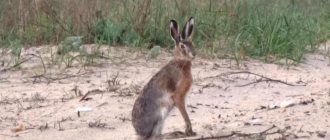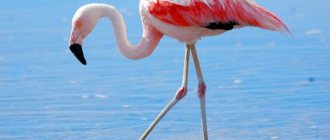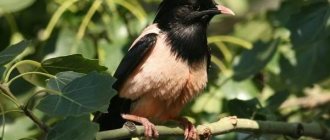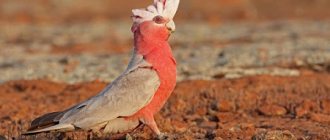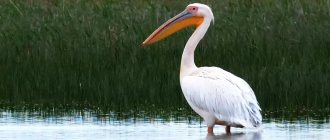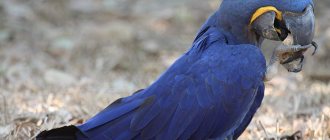This bird belongs to the flamingoformes and lamelliformes. In fact, flamingos are very ancient animals, they have existed for more than 30,000,000 years. They appeared in Asia and Africa, but the remains of these amazing creatures are found in America and Europe. Geese are a related species, although flamingos are similar in appearance to herons. The name of the species comes from the word “flamma”, which means fire from Latin.
These birds usually do not nest; the species is migratory. At least, individuals from Russia and Kazakhstan lead such a lifestyle.
Kinds
There are several types of flamingos, namely the pink, Caribbean, Chilean, Andean and lesser subspecies. There is also James' flamingo.
Pink flamingo
Caribbean flamingo
Chilean flamingo
Andean flamingo
Flamingo James
Common pink flamingos are the largest. The animals weigh more than 4 kilograms, and their height is about one and a half meters. Representatives of the small subspecies are much smaller: their height is less than a meter.
Lifestyle
Most species of flamingos lead a sedentary lifestyle. The exception is the pink flamingo. This representative of the family lives in a temperate climate and is forced to fly to another place every season. Sometimes the migration of flamingos is caused by depletion of water bodies and lack of food. Flocks of flamingos are distinguished by their endurance and can fly up to one and a half thousand kilometers without interruption.
Flamingos have developed a unique social system of living. As mentioned above, these birds live in large flocks, which are in turn divided into clans depending on the period of laying eggs. They reproduce only in flocks; those living alone do not produce offspring.
Flamingo in flight
Conservation status
The population size is quite unstable. The species is listed in the Red Book of the world, but over the past 10 years the number has not decreased significantly. Although some populations are losing their habitats due to human activity.
Another factor reducing the number is hunting for animal eggs. You can see them in many restaurants. Thus, the masonry is constantly emptied. Water and soil pollution also plays a huge role, causing individuals to get sick and die. An equally important cause of death is anxiety caused by the desire to stroke or touch the animal.
beautiful flamingos
Appearance
The birds are quite large, on average their height ranges from 130 to 140 cm, and their weight ranges from 2 to 4 kg. The wingspan of the animal can reach 160 cm. Sexual dimorphism is expressed in the size and length of the legs: females are smaller and their legs are shorter. The bird's head is not very large, the beak is knee-shaped in the middle. Thanks to the developed jaw apparatus, flamingos can search for small food in the water. There are plates in the beak itself; plankton, the favorite food of animals, settles on them.
Flamingo legs are long, each has 4 toes, the first three of which are connected by a membrane. The latter is located above the foot itself. The neck is strongly arched. The plumage of birds is soft, it often gets wet and therefore the animals do not go deep into the water. The color of the feathers usually varies from pink to red, but the tips of the hairs are always black. The pink tint is given by carotenoids in the fabric. Flamingos obtain these substances from food. In captivity, this shade fades if the bird is not fed carrots and beets. Juveniles are usually gray; only by the age of 3 do their feathers acquire a pinkish tint.
Birds usually live near lakes; they love alkaline water and food found there or in salty moisture. The salt glands in the body allow them to remove all the salt.
Characteristic features, structure of birds
Flamingos have long, thin legs that allow them to roam freely in shallow water. There are membranes on the toes that allow the bird not to get stuck in the mud. Birds have a long flexible neck, which helps them bend low and search for prey in the water. But the most recognizable feature of flamingos of all species is their wide, downward-curved beak.
Flamingos can often be seen standing on one leg. At this time, they tighten the other one to reduce heat loss, since their thin, long limbs have a fairly large surface. In windy weather, birds freeze. Standing on one leg does not cause them any discomfort and is natural. It is not difficult for flamingos to hold it in an extended position; this pose does not require any special muscle effort from them. The skin on the legs of birds is very dense. Thanks to this, they can live near very salty and even alkaline lakes and wander around them for several hours, looking for food.
Where the pink flamingo lives, the water is often unsuitable for drinking. But some planktonic organisms, for example brine shrimp, which make up the main part of the pink flamingo’s diet, live in very salty water, thrive in it and reproduce, also due to the lack of fish, which simply cannot live in such reservoirs. Therefore, flamingos are very fond of such reservoirs. However, they can fly to freshwater reservoirs and springs to wash off excess salt and drink.
The voices of different types of flamingos have characteristic features, but all of them are not distinguished by melody. These sharp and rough sounds are most reminiscent of the cackling of geese.
Habitats
Flamingos live in Asia, southern Europe and Africa. The Chilean subspecies inhabits the tropics and subtropics of the Andes, and red flamingos live on the Caribbean islands.
The pink flamingo creates nests mainly in France and Spain, Russia and Kazakhstan. They deviate from the route during migration more than any subspecies and therefore sometimes fly to Transbaikalia. Every year, animals create nests on Lake Tengiz and Kurgaldzhino. Sometimes this happens in the Caspian region and near small lakes in Kazakhstan. Another colony is the Kyzylgach Reserve.
In Europe, the Camargue has the most nests; it is located in Southern France. Usually in the spring there are about 20-25 thousand birds here. In Africa, birds create nests near the lakes of Morocco, Kenya and northern Mauritania, and southern Africa. Another nesting area is North-West India. Flamingos live on the coasts; they prefer salt lakes in the steppe.
Often, nesting habitat changes when areas become dry. At the end of the 50s of the last century, the population was larger, and now the number of animals is about 11,000 pairs.
Where does the flamingo live?
Flamingos do not live alone. They always unite in flocks, which are called colonies, and choose convenient places to live, located on the banks of small bodies of water. Birds prefer to settle in areas where they can get enough food, where they will not need additional long flights to search for food. Thus, birds choose to live in areas with a warm climate.
In some colonies you can find up to 100 thousand individuals.
The highest concentration of flamingos, as several million years ago, is found in the territories of Southeast and Central Asia and Africa. At the same time, birds also live in other areas that are suitable for a comfortable existence. The common flamingo lives in the southern parts of Spain and France, as well as in Kazakhstan and India. These are the only representatives of the family that are capable of making long flights, and during the migration period they can significantly deviate from the planned route, staying closer to the northern regions.
Extremely similar to the common flamingo, the Chilean variety lives in the tropical and subtropical territories of the South American Andes. In addition, on the islands of the Caribbean Sea there are colonies of the brightest colored flamingos - Caribbean or red.
Andean flamingos live high in the mountains, which are located at an altitude of 4 thousand meters above sea level.
Another highland species, the James flamingo, was previously thought to be extinct until its nests were discovered in Bolivia. Currently, the James flamingo lives in the Andes mountains in Peru, Argentina and Chile.
In the territories of African salt lakes there are the most numerous colonies of the smallest representatives of flamingos - small flamingos.
Elena
Ask a Question
Question to the expert
Can flamingos swim?
Flamingos can swim, although they do so quite rarely. Their long legs do not prevent them from swimming, since between their toes there are membranes that help them not only swim through the water, but also not fall into soft clay. Flamingos have membranes that resemble a mesh, due to which they can push off the water while swimming.
Lifestyle and social behavior
Birds are usually more active during the daytime and spend the night sleeping. These are animals that almost always live in colonies. In such conditions, nests are located close to each other, which is why conflicts occur. During them, flamingos cackle and straighten their feathers. However, these quarrels quickly end.
There are always guard birds in the flock who carefully monitor the situation, protecting the rest of the flock. In most cases, animals suffer from droughts or floods, and not from enemies in nature.
During winter migrations, many birds fly to Iran, some spend this time in nature reserves, especially the Kazakh populations.
Nutrition and feeding behavior
Interestingly, a group of these flamingos can consume approximately 140 tons of food per day. Birds mainly feed on crustaceans and their eggs. They also love insects and worms and look for them in the water. They can look for food near the lake where their nest is, but they can also fly to other bodies of water 50 km away. Feeding takes place in different ways: the Chilean and pink flamingos have such a beak structure that large objects are retained in the oral cavity, and the small subspecies has a strainer that is capable of catching groups of single-celled organisms.
At the beginning of feeding, the animals trample down the mud and only then dig into it with their beaks. Usually they lower their head down strongly, move their beak in different directions, and their tongue plays the role of a piston and filters the moisture for plankton. If the depth of the lake is deep, they submerge their entire head.
Birds drink water mainly during the rainy season; they lick the moisture from their feathers.
We need to save
Yes, flamingos are a bird in the Red Book, which, unfortunately, already has an entry on its pages. Nowadays, there is a struggle to preserve them. From whom should these creatures be protected? In their natural habitat, they have enemies - predators who not only hunt adult individuals, but also destroy their eggs. Moreover, these are not only foxes, badgers, hyenas, baboons, wild boars, but also Turkish vultures and yellow gulls. Also, the enemy of the flamingo is man. He eats the eggs and meat of these beautiful birds. He also uses feathers that have an unusual color.
Reproduction
All flamingos are monogamous; they mate for both a season and a couple of years. All mating rituals begin with demonstrations of their masculinity, this happens about 2 months before flamingos create nests. During this period they are aggressive, although at other times they are quite calm. When courting, animals scream loudly, spread their wings and run in large groups, raising their legs very high.
They often take abrupt breaks during their manhood runs. Typically, mating rituals are very specific within a species. Individuals from different species do not create pairs, and hybrids are also unknown.
After forming, couples become so close that they always defend their partner and do everything in sync. They scream together.
The clutch contains several white eggs. Both parents incubate and feed the young. Incubation lasts about a month; in particularly hot climates, this protects the chicks from overheating. They hatch with sight, and newborns have a straight beak. By the time the flamingo begins to be born, the parents' crops are enlarged several times. From there, a special milk is secreted, which consists of digested crayfish, insects and mucus from the organ itself. This liquid is pinkish because it contains the blood of the inhabitants that the flamingo feeds on. The composition of the milk is very similar to colostrum. The female and male feed their young with this.
Flamingo chick
Within a couple of days after birth, the chicks leave their nest, and when they turn one month old, the outfit changes to a new one. Two weeks after hatching, the beak becomes curved. Those chicks that were left without parents for some period because they flew away in search of food begin to create groups. They are controlled by individuals - guards left by their parents. Upon returning, the female and male feed the chicks with milk from the crop.
Cubs begin to fly only in the second month of life, or even by the 80th day of life. Around the same time, the chicks develop a filtering apparatus. Individuals become sexually mature only at 5 years of age.
Hatching of chicks lasts from 24 to 36 hours
The chick often screams as it breaks through the shell. To destroy it, he uses a growth on his beak called an “egg tooth.” This is not a real tooth and falls off shortly after hatching.
Newly hatched chicks have gray or white down feathers, a straight red beak and swollen red or pink legs. The swelling of the legs subsides about 48 hours after hatching, and the red beak and feet turn black after seven to ten days. At first the chick is not very active. Movement is limited to pushing the wings or raising the head.
Photo: www.kids.sandiegozoo.org
After hatching, the chick remains on the mound for 5 to 12 days. During this time, it is fed "milk", a secretion from the upper digestive tract (flamingos share this trait with pigeons). “Milk” secretion is caused by prolactin, which is produced by both males and females. Flamingos can even act as foster feeders. It is believed that the requests made by a hungry chick stimulate the secretion of milk. Milk contains 8-9% protein and 15% fat, just like mammalian milk. It is red in color due to the pigment canthaxanthin.
The chick will first leave the nest after four to seven days, when it is strong enough to stand and walk. The parents closely monitor their chick as it explores its environment. The young gather in large groups called creches. But parents can easily recognize their chick by its appearance and voice.
Flamingo chicks can swim before they are old enough to leave the nest for good. Their flight feathers begin to grow after 11 weeks. At the same time, the beak begins to cling, allowing the chick to feed itself. The young gradually lose their gray or white color over two or three years, after which pink feathers begin to appear.
Enemies
In bird colonies there are several thousand individuals and they all become a tasty morsel for their enemies. The most dangerous animals for flamingos are falcons and kites. They constantly steal animal eggs and chicks. But during nesting, individuals in the colony always defend the clutches of others. However, wolves, foxes and jackals also hunt birds. Predators love flamingo meat, and it is easy to catch them: you just have to ambush an individual standing far from the others in shallow water. There are also frequent cases when these predators settle nearby and then many flamingos die.
Security
In the 1950s, the James flamingo was thought to be extinct, but in 1957 a colony of these birds was discovered in Bolivia. Today the number of this species is already 50,000, the same number of individuals of the Andean subspecies. To preserve the species, zoos were created in Switzerland and the USA. However, if you try to move the colony, sooner or later the individuals will return to where they were born.
Interesting Facts
- Flamingos create nests from mud, which is located near the lake under a crust of gypsum. Shell rock is also used for the same purposes.
- The shape of the nest is a cone, it is about 1.5 meters in height.
- Individuals of the Andean subspecies have yellow legs.
- The largest flocks are created in eastern Africa; scientists count about 1 million individuals in one colony.
- In flight, flamingos do not flap their wings; they can reach speeds of about 50 km/h.
- If you stretch the bird's neck in a straight line, its length will be equal to the length of the flamingo's legs.
- Birds often come to sources of fresh water to cleanse themselves of alkali and salt.
- In zoos, flamingos are fed carrots, gammarus and even minced fish. This is mixed with food containing proteins and water is added. They will receive such food once a day, and they are given dry feed several times a day.
- The flamingo population in the Mediterranean consists of 60,000 birds.
- Most of all, flamingos like to winter in Italy, especially in Sardinia and Puglia. They began to spend the winter there since the 1990s of the last century.
- In the ancient Mesopotamian empire, the flamingo was called the bird of light; in Kikuyu, the name of the bird is translated as “long neck.”
- The Chilean subspecies was described by Darwin in his 1860 work, previously classified as the subspecies ruber.
The connection between flamingos and representatives of the grebes is almost confirmed in the world of scientists; together they form a whole group, which is called Mirandornith. Ernst Mayer, a famous zoologist, thinks so too.
This is not a myth
But the chicks also recognize their parents by the voice they hear at a distance of 100 meters. They approach them, having caught a special call. It is not customary for flamingos to feed other people's chicks. If the parents do not do this, the baby will die of hunger. It turns out that bird's milk is not fiction. It is this drink that flamingos feed their chicks. Moreover, it is very similar in composition to human, and is produced thanks to the hormone prolactin. Only chicks, of course, feed differently than young mammals. Bird milk is secreted from a special nutritious secretion, which is located in the beak of an adult bird. It is noteworthy that it is not white, but red. Together with it, the first pigments enter the chick's body, which color its feathers pink.
